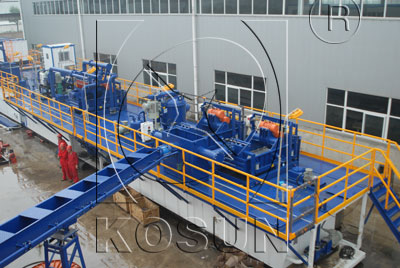Sep 09, 2013
Solids control is a technique used in drilling rig to separate the solids in the drilling fluids that are crushed by the drilling bits and carried out of the well surface. Normally solids control system is consisted of five stages, including mud tank, shale shaker, vacuum degasser, desander, desilter, centrifuge. Shale shaker is used to separate the big solids with diameter above 75μm, and 45~74μm for desander, and 15~44μm for desilter. Sometimes desander & desilter are combined as highly efficient mud cleaner. When air enters the drilling fluids, vacuum degasser is used to separate the air. If no air is found in the mud, the degasser will work as a big agitator. All these equipment are mounted on the top of the mud tank. After separating the solids, the clean mud will be pumped into the borehole again.
Good solids control procedures are often ignored in many oil & gas drilling projects. Many people do not understand very well the basic principles of drilling fluids solids control. They persist that drilled solids are evil & insidious. In a short term, the increase of drilled solids generally does not reveal their economic impact immediately, and the detrimental effects are also not immediately obvious on the drilling rig. But in a long term, increase of drilled solids will generate many problems on drilling rigs. So drilled solids need to be removed at the surface by solids control equipment, such as shale shaker, mud cleaner, centrifuge, etc. to reduce the risk.

Drilled solids damage reservoirs, increase drilling cost, and also create large drilling processing disposal cost. To drill an oil or gas well fast, safely, and under budget, it is necessary to remove the drilled solids which not only include drilling cuttings, but also sloughs that drop from the wall of borehole. If these drilled solids can not be removed timely, they would cause many problems, including:
1. Filtrating damage to formation
2. Drilling rate limits
3. Drilling string stuck
4. Borehole problem
5. Lost circulation problem
6. Direct drilling fluids cost
7. Increasing disposal cost
Decreasing drilled solids is analogous to buying an insurance to an event that will not happen to drilling rig. Nobody wish these above-mentioned problems would occur, but they do exist, and they are real. The effects of drilled solids on economics of drilling a well is subtle, and the sincrease of drilled solids does not result in a disaster immediately on a drilling rig. When the drill bit ceases to work and torque increases, drillers know that it is time to pull the bit. But when the drilled solids increases, the detrimental effects are not apparent immediately.
That is why the drilling fluids is used to bring drilled solids to the surface, and it should be removed timely by the solids control equipment, such as shale shaker, desander, desilter, mud cleaner, centrifuge, etc. But not all the solids are removed, and it is also impossible to remove all the solids. Some solids that smaller than the shaker screen openings will stay in drilling fluids, and other additive agents, such as barite, clay, etc. are also essential to adjust drilling fluids property.